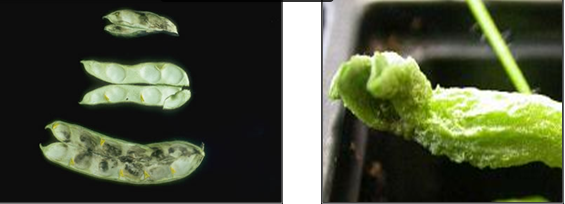Nematodes - faba bean
Contributors to this section: ICARDA, Syria (Siham Asaad, Abdulrahman Moukahal).
Stem and bulb nematode, Stem and bulb eelworm.
Scientific name
Ditylenchus dipsaci (Kühn, 1857) Filipjev, 1936.
Other scientific names
Tylenchus dipsaci (Kühn) Bastian, 1865. Ditylenchus phloxidis Kirjanova, 1951.
Ditylenchus fragariae Kirjanova, 1951.
Significance
D. dipsaci is one of the most devastating plant parasitic nematodes, especially in temperate regions. Without control, it can cause complete failure of host crops.
Symptoms
D. dipsaci causes swelling and deformation of stem tissue or lesions which turn reddish-brown then black, depending on cultivar and environmental factors. Newly formed pods take on a dark-brown appearance. The lesions envelop the stem and increase in length, often advancing to the edge of an internode. Leaf and petiole necrosis is also common under heavy infestations, but can be confused with symptoms induced by fungal leaf pathogens. Infected seeds are darker, distorted, and smaller in size and may have speckle-like spots on the surface. Heavy infestations often kill the main shoots, stimulating secondary tiller formation. The more severe symptoms are usually induced by the "giant race" on legumes.
Hosts
D. dipsaci is known to attack over 450 different plant species, including many weeds. However, it occurs in more than ten biological “races” some of which have a limited host-range. The race(s) that breed on rye, oats and onions seem to be polyphagous and can also infest several other crops, whereas those breeding on lucerne, Trifolium pratense and strawberries are virtually specific for their named hosts and seem to have relatively few alternative host plants. The tulip race will also infest Narcissus, whereas another race commonly found in Narcissus does not breed on tulip. It is known that some of the races can interbreed and that their progeny have different host preferences.
The principal hosts are faba beans, garlic, Hyacinthus orientalis, leeks, lucerne, maize, Narcissus pseudonarcissus, oats, onions, peas, Phlox drummondii, P. paniculata, potatoes, rye, strawberries, sugarbeet, tobacco, Trifolium pratense, T. repens, tulips. It has also been reported on carnations, celery, Hydrangea, lentils, rape, parsley, sunflowers, and wheat.
Geographic distribution
D. dipsaci occurs locally in most temperate areas of the world (Europe and the Mediterranean region, North and South America, northern and southern Africa, Asia and Oceania) but it does not seem able to establish itself in tropical regions except at higher altitudes that have a temperate climate. In most countries regulatory measures (e.g. certification schemes) are applied to minimize further spread of D. dipsaci.
Biology and transmission
In international trade D. dipsaci is liable to be carried on dry seeds and planting material of host plants. In the field the fourth-stage juvenile can withstand desiccation for many years, and although soil densities seem to decrease rapidly, the nematode can survive for years without a host plant. Nematode survival and damage are greater in heavy soils as compared to sandy soils. It can also survive on a number of weeds. Irrigation water and cultivation by contaminated farm tools and machinery are other sources of inoculum dissemination.
Detection/indexing method at ICARDA
- Nematode extraction test
Treatment/control
- Control by crop rotation is limited by the polyphagous habit of some races of D. dipsaci and by persistence of the nematode in clay soils. Chemical treatments of the soil are not an economic proposition for large areas. However, it may sometimes be worth treating small patches, after lifting and destroying the affected plants (bulbs) together with a margin of surrounding healthy ones, to eradicate a slight infestation before it spreads.
- Nematode-free (certified) seeds and planting material are most essential to prevent crop damage by D. dipsaci. Hot-water treatments with different temperature-time combinations, depending on type and state of seed material, are operational and efficient to control D. dipsaci. Systemic nematicides may be effective to some extent Ditylenchus dipsaci in controlling D.dipsaci in some ornamental crops. The use of tolerant or resistant cultivars can also reduce the damage.
- In laboratory experiments faba bean bulbs were heat treated in an attempt to control Ditylenchus dipsaci. A wide range of temperatures (43 to 50 deg C) and treatment times (30, 60, 120 min) was tested but none was successful. Chemical treatment, particularly preplanting treatment, was more successful. Calcium polysulphide (8%) and nemaphos (0.1 and 0.2%) were very effective.
Procedure followed at the centers in case of positive test
- Fumigation, rotation.
References and further reading
http://www.eppo.org/QUARANTINE/nematodes/Ditylenchus_dipsaci/DITYDI_ds.pdf
http://www.doacs.state.fl.us/pi/enpp/nema/nemacirc/nem187.pdf
http://www.ipmimages.org/browse/detail.cfm?imgnum=0162066
 Stem and bulb nematode (photos:www.ipmimages.org/) |
Comments
- No comments found





Leave your comments
Post comment as a guest